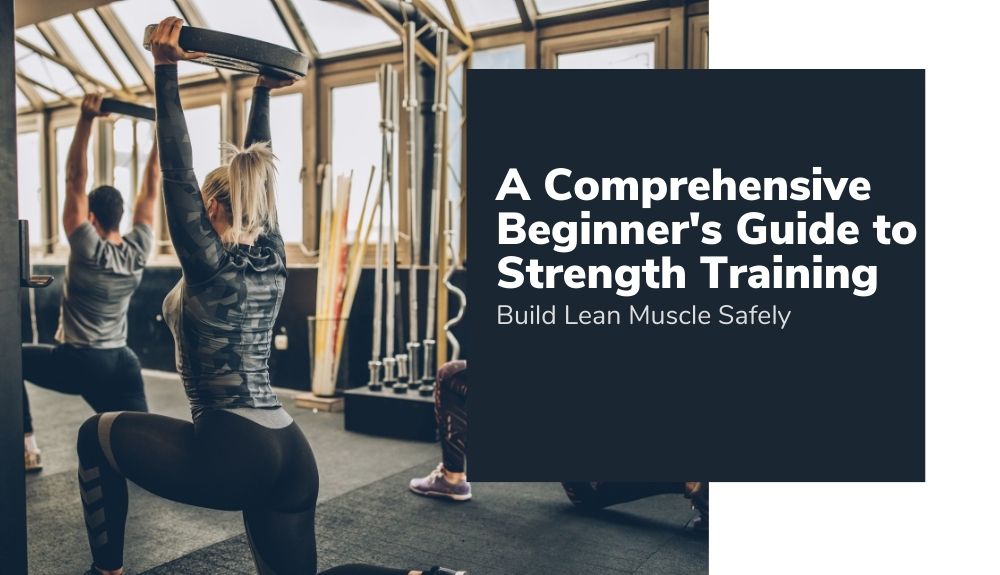Have you ever wanted to build lean, sculpted muscles but weren’t sure where to start? Look no further! In this comprehensive beginner’s guide to strength training, we’ll take you through everything you need to know to build lean muscle safely and effectively.
Starting a strength training routine can be daunting, but with the right knowledge and guidance, anyone can embark on this transformative journey. Whether you’re a complete novice or someone who’s dabbled in strength training before, this guide will provide you with the tools and insights to kickstart your muscle-building goals.
Throughout this blog, we’ll cover essential topics such as proper form and technique, effective exercises for beginners, and the benefits of strength training for muscle development. You’ll also discover how to set goals, track your progress, and maintain motivation on your strength training journey.
So, if you’re ready to unlock your potential and sculpt the physique you’ve always dreamed of, join us as we dive into the world of strength training. Get ready to take the first steps towards a stronger, healthier you. Let’s get started!
Introduction to Strength Training
Strength training is a form of exercise that focuses on building muscle strength and power. Unlike cardio exercises that primarily target endurance, strength training involves using resistance to challenge your muscles. This can include lifting weights, using resistance bands, or even utilizing your body weight.
One of the key benefits of strength training is its ability to help you build lean muscle mass. When you engage in strength training exercises, your muscles are forced to overcome resistance, which promotes muscle growth and development. Along with muscular changes, strength training also leads to improved bone density, increased metabolism, and enhanced overall body composition.
Moreover, strength training offers various benefits for both men and women. It can help decrease the risk of injury, improve posture and joint stability, enhance athletic performance, and even boost self-confidence. By incorporating strength training into your fitness routine, you can achieve a well-rounded and functional physique.
In conclusion, strength training serves as a highly effective method for building lean muscle and improving overall physical health. As we delve deeper into this beginner’s guide, you will gain a better understanding of essential techniques, exercises, and safety precautions to ensure a safe and successful strength training experience. So let’s get started on your muscle-building journey!
Understanding the Basics
Strength training is a foundational component of building lean muscle and improving overall physical fitness. Understanding the key concepts of strength training will help you develop proper form, activate the targeted muscles effectively, and implement progressive overload techniques for optimal results.
Proper Form: The Foundation of Strength Training
Proper form is crucial in strength training to avoid injuries and maximize muscle activation. Focus on maintaining correct posture, engaging the core, and using a full range of motion for each exercise. Start with lighter weights to master the technique before progressing to heavier loads.
Muscle Activation: Targeting Specific Muscles
In strength training, it’s essential to activate the specific muscles you aim to develop. Mind-muscle connection is key – concentrate on feeling the targeted muscles working throughout each repetition. Visualize contracting and squeezing the muscles to enhance muscle activation.
Progressive Overload: Continual Muscular Adaptation
Progressive overload is the principle of gradually increasing the challenge placed on your muscles over time. This can be achieved by increasing the weight, reps, or sets of an exercise. By continuously pushing your muscles outside their comfort zone, you stimulate growth and strength gains.
It is important to note that progressive overload should be implemented gradually to prevent overexertion and minimize the risk of injury. Start with manageable weights and progress steadily as your strength and technique improve.
Remember, whether you are starting with bodyweight exercises or using equipment like dumbbells or resistance bands, always prioritize proper form and muscle activation. These foundational elements will set the stage for your strength training journey and pave the way for optimal muscle development and overall fitness.
Essential Equipment and Safety Guidelines
When starting your strength training journey, it’s important to have the right equipment and follow safety guidelines to ensure a safe and effective workout. Here are some essential equipment and safety guidelines you should consider:
Equipment for Strength Training
1. Dumbbells: Dumbbells are versatile and allow for a wide range of exercises. Start with a set of dumbbells with varying weights to accommodate different exercise levels.
2. Barbell: Barbell exercises like bench press and squats can target multiple muscle groups simultaneously. If you’re a beginner, make sure to start with a lighter weight and gradually increase as you gain strength.
3. Resistance Bands: Resistance bands provide a convenient and portable option for strength training. They come in different resistance levels, allowing you to adjust the intensity of your workouts.
4. Weight Bench: A weight bench provides support and stability during exercises such as chest presses and seated shoulder presses. Look for an adjustable bench that allows for different incline positions.
5. Exercise Mat: An exercise mat provides cushioning and grip for floor exercises and stretches.
Safety Guidelines for Strength Training
1. Warm-up: Always start with a dynamic warm-up to increase blood flow and prepare your muscles for the workout.
2. Proper Form: Learn the correct form for each exercise to ensure maximum effectiveness and minimize the risk of injury. Consider working with a personal trainer or watching instructional videos for guidance.
3. Progress Gradually: Gradually increase the weight and intensity of your workouts to avoid overexertion and reduce the risk of muscle strains or joint injuries.
4. Rest and Recovery: Allow your body ample time to recover between workouts. Aim for at least one day of rest between strength training sessions to prevent overtraining.
5. Hydration and Nutrition: Stay hydrated before, during, and after your workouts. Fuel your body with a balanced diet to support muscle recovery and growth.
Remember, safety is paramount in strength training. If you have any underlying health conditions or concerns, consult with a healthcare professional before starting a new exercise routine.
Top Exercises for Beginners

When starting with strength training, it’s important to choose exercises that are suitable for beginners. These exercises will help you build a solid foundation and develop proper form, allowing you to progress safely and effectively. Here are some recommended exercises to include in your beginner’s strength training routine:
1. Squats
Squats are a compound exercise that engages multiple muscle groups, including your quads, hamstrings, glutes, and core. They help improve lower body strength and stability. Stand with your feet shoulder-width apart, lower your hips down as if sitting into a chair, and then push back up to the starting position.
2. Push-ups
Push-ups are great for strengthening your chest, shoulders, triceps, and core muscles. Start in a high plank position with your hands slightly wider than shoulder-width apart. Lower your body by bending your elbows, keeping your core engaged, and then push back up to the starting position.
3. Lunges
Lunges target your quadriceps, hamstrings, glutes, and core muscles. Begin by standing with your feet hip-width apart. Take a step forward with one foot, keeping your front knee directly above your ankle as you lower your body down towards the ground. Push through your front foot to return to the starting position, and then repeat on the other side.
4. Bent-Over Rows
Bent-over rows strengthen your back, shoulders, and biceps. Stand with your feet hip-width apart, hinge forward at your hips with a slight bend in your knees, and hold a dumbbell in each hand. Pull the dumbbells towards your chest, squeezing your shoulder blades together, and then lower them back down.
5. Planks
Planks target your core muscles, including your abs, lower back, and glutes. Start in a high plank position, with your hands directly under your shoulders and your body in a straight line from head to heels. Engage your core and hold this position for as long as possible.
Remember to focus on maintaining proper form and technique for each exercise. Start with lighter weights or bodyweight and gradually increase the intensity as you gain strength. Incorporate these exercises into your beginner’s strength training routine to build a strong foundation and progress towards your fitness goals.
Structuring a Beginner’s Workout Routine
When starting a strength training journey as a beginner, it’s crucial to have a well-structured workout routine. By following a proper plan, you can maximize your results and minimize the risk of injuries. Here is a sample workout routine to help you get started:
Warm-Up (5 minutes)
– Start your workout with a 5-minute warm-up consisting of light cardio exercises such as jogging, jumping jacks, or cycling. This will increase your heart rate, warm up your muscles, and prepare your body for the upcoming workout.
Compound Exercises (45 minutes)
– Compound exercises involve multiple muscle groups and are excellent for building overall strength and muscle mass. Aim to perform 3 sets of 8-12 reps for each exercise, with a 1-2 minute rest between sets.
1. Squats: Begin with bodyweight squats and gradually add weights as you progress. This exercise targets your leg muscles, including the quadriceps, hamstrings, and glutes.
2. Bench Press: Use dumbbells or a barbell to perform bench presses. This exercise targets your chest, shoulders, and triceps.
3. Bent-Over Rows: Use a barbell or dumbbells to perform bent-over rows. This exercise targets your back muscles, including the lats and rhomboids.
4. Overhead Press: Use dumbbells or a barbell to perform overhead presses. This exercise targets your shoulders and triceps.
5. Deadlifts: Use a barbell or dumbbells to perform deadlifts. This exercise primarily targets your lower back, glutes, and hamstrings.
Isolation Exercises (20 minutes)
– Isolation exercises focus on specific muscle groups and help improve muscle definition and symmetry. Aim to perform 3 sets of 10-15 reps for each exercise, with a 1-minute rest between sets.
1. Bicep Curls: Use dumbbells or a barbell to perform bicep curls. This exercise targets your biceps.
2. Tricep Dips: Use a bench or a chair to perform tricep dips. This exercise targets your triceps.
3. Lateral Raises: Use dumbbells to perform lateral raises. This exercise targets your shoulder muscles.
Cool-Down (5 minutes)
– Finish your workout with a 5-minute cool-down consisting of stretching exercises for all major muscle groups. This will help prevent muscle soreness and improve flexibility.
Remember to start with lighter weights and gradually increase the resistance as your strength and technique improve. Proper form is essential to avoid injuries, so make sure to maintain good posture and use controlled movements throughout each exercise. Stay consistent with your workouts, giving yourself at least one day of rest between strength training sessions to allow your muscles to recover and grow.
Tracking Progress and Setting Goals
Setting goals and tracking progress is crucial for a successful strength training journey. By monitoring your progress, you can stay motivated and make necessary adjustments to your workouts. Follow these tips to effectively track your progress and set realistic goals:
Keep a Workout Journal
Maintain a workout journal to record your exercises, sets, reps, and weights used. This will help you track your progress over time and identify areas where you can challenge yourself.
Measure Body Metrics
Regularly measure your body metrics such as weight, body fat percentage, and measurements of specific muscle groups. These measurements can provide valuable information on your body composition and muscle development.
Set SMART Goals
Set Specific, Measurable, Achievable, Relevant, and Time-Bound (SMART) goals. For example, aim to increase your bench press weight by 10 pounds within the next two months. This gives you a clear target to work towards.
Celebrate Milestones
Acknowledge and celebrate small milestones along the way. It could be achieving a certain number of chin-ups or increasing your squat weight. Celebrating these achievements will keep you motivated and boost your confidence.
Regularly Evaluate and Adjust
Periodically evaluate your progress and adjust your goals as necessary. If you find that you’re consistently surpassing your targets, set more challenging goals to continue your growth.
Remember, progress in strength training is a gradual process. Be patient with yourself and celebrate every step forward. With proper tracking and goal-setting, you’ll stay motivated and achieve the results you desire.
Nutrition and Recovery Tips
Proper nutrition and recovery strategies play a crucial role in supporting muscle growth and preventing overtraining. Here are some valuable tips to optimize your strength training journey:
1. Fuel Your Body with Adequate Macronutrients
To support muscle growth and recovery, it’s essential to consume a balanced diet that includes an adequate amount of protein, carbohydrates, and healthy fats. Protein is particularly important as it provides the building blocks for muscle repair and growth. Aim for around 0.8 to 1 gram of protein per pound of body weight. Additionally, carbohydrates provide energy for your workouts, while healthy fats contribute to overall health and hormone production.
2. Prioritize Post-Workout Nutrition
After a strength training session, your body is in a prime state to absorb nutrients and initiate muscle repair. Consuming a combination of protein and carbohydrates within 30 to 60 minutes after your workout can help optimize recovery. Consider options like a protein shake with fruit or a balanced meal containing lean protein and complex carbohydrates.
3. Hydrate Properly
Staying hydrated is crucial for overall health and performance in strength training. Adequate water intake helps regulate body temperature, cushion joints, and transport nutrients to muscles. Aim to drink enough water throughout the day and especially during your workouts. Keep a water bottle handy and sip frequently to maintain hydration levels.
4. Get Sufficient Rest and Sleep
Rest and recovery are just as important as your workout sessions. During strength training, you create tiny tears in your muscles, and it’s during rest periods that these muscles repair and grow stronger. Make sure to include rest days in your workout routine to allow your body to recover. Additionally, prioritize quality sleep as it plays a vital role in muscle recovery and overall well-being.
5. Monitor and Listen to Your Body
Pay attention to any signs of overtraining or excessive fatigue. Pushing yourself too hard without proper recovery can lead to increased injury risk and hinder progress. If you feel excessively sore, fatigued, or experience prolonged muscle soreness, consider incorporating more rest days or reducing the intensity or volume of your workouts.
6. Consider Taking Supplements
While a well-balanced diet should provide you with the necessary nutrients, some individuals may benefit from specific supplements. Consult with a healthcare professional or registered dietitian to determine if supplements, such as protein powders, creatine, or omega-3 fatty acids, are suitable for your needs.
Remember, proper nutrition and recovery strategies are essential components of a successful strength training journey. By fueling your body with the right nutrients and allowing ample time for rest and recovery, you can maximize your muscle growth, prevent overtraining, and achieve your fitness goals.
Common Mistakes to Avoid

When starting your strength training journey, it’s important to be aware of common mistakes that beginners often make. By avoiding these pitfalls, you can ensure a safe and effective experience. Here are some key mistakes to watch out for:
1. Skipping Warm-Up Exercises: Neglecting warm-up exercises can increase the risk of injury. Always start with dynamic stretches and light cardio to prepare your muscles for the workout.
2. Poor Form: Incorrect form can diminish the effectiveness of an exercise and increase the chance of injury. Take the time to learn the proper technique for each exercise and focus on maintaining good form throughout your workout.
3. Lifting Too Heavy: It’s tempting to lift heavy weights right from the start, but this can lead to muscle strain and poor form. Begin with lighter weights and gradually increase the resistance as your strength improves.
4. Neglecting Rest and Recovery: Rest days are crucial for muscle repair and growth. Overtraining can lead to exhaustion, decreased performance, and even injury. Ensure you incorporate rest days into your workout routine.
5. Lack of Variety: Doing the same exercises repeatedly can lead to plateaus and boredom. Include a variety of exercises that target different muscle groups to keep your workouts challenging and engaging.
6. Neglecting Nutrition: Proper nutrition is vital for muscle growth and recovery. Ensure you fuel your body with a balanced diet that includes an adequate amount of protein, carbohydrates, and healthy fats.
7. Setting Unrealistic Goals: Setting unrealistic goals can lead to disappointment and frustration. Set measurable and achievable goals that can be tracked and celebrate your progress along the way.
8. Comparison to Others: Comparing your progress to others can discourage and demotivate you. Remember that everyone’s fitness journey is unique, and focus on your own progress and improvements.
By avoiding these common mistakes, you can maximize the benefits of strength training and progress towards your goals safely and effectively. Keep in mind that consistency, patience, and listening to your body are key to success in your fitness journey.
Conclusion
Structuring your beginner’s workout routine is key to ensuring a safe and effective strength training experience. By following this sample plan and gradually increasing the intensity, you can build lean muscle mass and improve your overall strength. Remember to consult with a fitness professional if you have any concerns or specific goals.





















